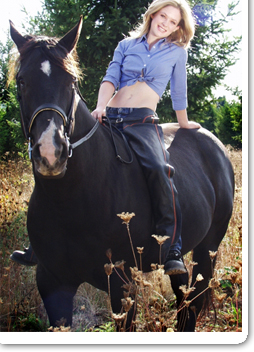|
I Knew Her For An Eternity |
Horse Training Mistakes |
Horse Training 101
How to groom your horse |
The Western Cowboy
|
|
Horse Training 101
Each horse is different in how it learns and how it reacts
to outside stimuli. Certain methods of horse training may
apply to some horses, but it does not mean that it will be
effective to all breeds of horse.
To start horse training you must develop a communication system
with the horse. This might take time. In the same way as children
may not fully grasp the idea of things at an instant, baby
horses in training may not get every pressure, pat or way
of holding the reins at once.
When you apply a certain pressure, you expect a certain response.
During horse training, you must make the horse understand
that a certain pressure should elicit a corresponding response.
We don’t expect full compliance in the beginning, but
as time goes by, these actions will be part of the horse’s
vocabulary.
Throughout the course of the horse training, one by one these
actions will be added to his vocabulary. But these actions
should still be broken down into minute details that the horse
can take in one at a time. Learn how to pace with each individual
horse. Training is something that should be done slowly and
surely.
You must also learn how to “speak” to your horse
in a way that it will be able to comprehend. This manner of
speaking would mean fewer words and more body language.
Horses are herd animals. They learn well by imitating the
leaders of the herd. You should be that “leader”
your horse will follow. Patience is a key in training your
horses.
You must also take into consideration that no one, animal
or human, learns well when under stress. You should not force
lessons into your horse during horse training. They don’t
appreciate the yelling and whipping, especially if they do
not know what all the harshness is for. Unlike humans who
can speak their minds, horses resort to more physical responses.
And you certainly wouldn’t want your horse to whirl,
kick, strike and do out of hand movements.
You must create an environment wherein the horse can learn
on its own, aside from the horse training that you give it.
It is also important to see the difference between having
been able to teach the horse something and it just accepting
it. If a horse is relaxed when you do something, this does
not necessarily mean that it is trained. This might just mean
to it as another thing a human being normally does. Resistance
at first is needed in order to see that the horse recognizes
that something new is being taught to him.
The horse’s daily training routine should not be based
on a set of particular things you want to teach to the horse.
It should be based on how your horse reacts to your actions.
Don’t teach something new to it without reviewing what
it already knows.
Most importantly - don’t force your horse to go on horse
training if it doesn’t feel well. A good routine does
not only maintain the horse’s attention level, but also
its comfort level.
by Ray La Foy
|
